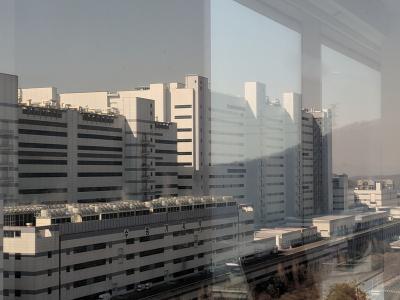OLEDs for laptops - introduction and industry news. - Page 4
Samsung Display formally starts building its A6 8.6-Gen IT AMOLED production line
Samsung Display announced that is is starting to build its 8.6-Gen AMOLED production line, that will target IT applications (laptops, tablets and monitors). The new A6 line, will be located at Samsung's old L8 LCD line in Asan, that will be converted to AMOLED production. The company held a ceremony today.
Samsung's plan is to install all the major production equipment by the end of 2024, and begin full-scale production in 2026.
Omdia updates its Apple laptop and tablet OLED adoption forecast, says market to grow to 72 million units by 2028
Omdia updated its forecast for Apple's OLED adoption in its IT devices (iPads and Notebooks), saying that the company will begin the OLED transition with the 11-inch and 12.9-inch iPad Pro due later in 2024.
Samsung Display and LG Display will be Apple's suppliers, and the two companies will adopt new technologies. SDC will produce rigid glass based LTPO tandem AMOLEDs and LG will produce flexible AMOLEDs, at its E6 line. Omdia estimates that Apple will pay $80-90 for the 11" displays and $120-130 for the 12.9" displays, without the touch and cover glass (which will add $20-30 per display).
LG Display said to be progressing with its 8.6-Gen IT AMOLED line plans, to announce its plans in H2 2024
According to recent rumors, LG Display has decided to go ahead and build its 8.6-Gen (2250 x 2600 mm) IT AMOLED line, in Paju, Korea (at its P10 hub, which was originally planned for OLED TV production). The company recently started to conduct discussions with equipment makers for supply agreements.

LG Display's plan is to officially announce its 8.6-Gen production line plans in the second half of the year, and start ordering equipment. It is likely that the capacity of the fab will be between 7,500 to 15,000 monthly substrates. LG will be using its P10 building and existing equipment (backplane deposition) to reduce the costs of the 8.6-Gen line. This will mean that there will be delays to LG's WOLED TV panel capacity expansion plans.
Omdia sees a rebound in the display production equipment market
Market research firm Omdia says that display production equipment sales will rebound in 2024 and reach $7.7 billion (154% over 2023), and will grow slowly in the near future, mainly driven by 8.6-Gen OLED production lines (used to make IT displays).
Omdia says that the new 8.6-Gen OLED fab require novel technologies, which results in high equipment costs. In 2024, 32% of all spending ($2.4 billion) will be for Samsung's A6 line, a large investment for a 15,000 monthly subtrates fab. BOE's investment in its upcoming B16 flexible 8.6-Gen line will be even higher - by 18% due to the backplane choice (LTPO over Samsung's oxide-TFT A6).
New OLED TVs, monitors, laptops and prototypes announced at CES 2024
During CES 2024, many device makers announced new laptops, monitors and TVs that use OLED displays. Here's a list of all these new devices:
- MSI Monarch 13 laptop (13.3" 2.8K AMOLED)
- LG OLED B4, C4, G4, M4 (WOLED TVs)
- Samsung Odyssey G9 monitor (49" 5120x1440 240Hz QD-OLED)
- Samsung Odyssey G8 / G6 monitors (27" 1440p 360Hz / 32" 4K 240Hz QD-OLED)
- Razer Blade 16 2024 laptop (16" 2560x1600 240Hz SDC AMOLED)
- Dell 2024 XPS 13 / 14 / 16 laptops (16" 90Hz 4K / 14.5" 120Hz 3200x2000 / 13.4" 2880x1800 60Hz AMOLED)
- Acer Predator X34 X / X39 monitors (4" / 39" 3440x1440 240Hz OLED)
- LG Signature OLED T (77" 4K wireless transparent WOLED TV)
- Samsung S95D, S90D, S85D (QD-OLED and WOLED TVs)
- Gigabyte AORUS 2024 QD-OLED monitors (27", 31.5", 34" QD-OLEDs)
- Acer 2024 Swift 14 X / Swift Go 14 / Swift Go 16 laptops (14" / 16" AMOLEDs)
- Panasonic Z93A, Z95A (WOLED TVs)
- HP Omen Transcend 32 gaming monitor (32" 240Hz 4K QD-OLED)
- Dell Alienware AW2725DF / AW3225QF monitors (27", 32" QD-OLEDs)
- HP 2024 Spectre x360 14 laptop (14" AMOLED)
BOE shows a dual-slidable laptop AMOLED display
BOE signs the official contract with Chengdu's local government to build its 8.5-Gen IT AMOLED line
BOE has been planning a 8.5-Gen flexible IT AMOLED Line for a couple of years, and in November 2023, following some delays, the company officially announced its plans for the new fab. Now we hear from China that the Chengdu local government, together with Chengdu's Hi-Tech Industrial Development Zone, have signed the contact with BOE to build the new plant.
The total investment in the fab is expected to reach 63 billion Yuan (over $8.7 billion USD). The fab will have a capacity of 32,000 monthly substrates (2290x2620 mm), and is expected to begin production by Q4 2026 (total construction time will be 34 months, according to the plan).
TCL CSoT reiterates plans to start producing inkjet printing OLEDs in 2024, to target IT displays
TCL CSoT says that it will start producing OLED displays using an inkjet printing process in the second half of 2024. This is excellent news and good to know CSoT is still on track for initial production in 2024. The company says it will first target the IT and medical sector.
The company says that the cost of producing OLEDs using its inkjet printed panels will be lower compared to the currently-used FMM based method, and its OLEDs will offer superior performance (in lifetime, mostly) as its process enables higher aperture.
BOE to build a $8.8 billion flexible IT AMOLED production line in Chengdu
Back in April 2022 it was reported that BOE started planning a 8.5-Gen IT AMOLED Line, to target the laptop and tablet markets. Following some delays, the company has now officially announced it plans and is set to start constructing the new fab.

Asus ZenBook 17 Fold OLED (BOE panel)
BOE says that it will invest 63 billion Yuan (over $8.8 billion USD) to build the new fab in Chengdu, Sichuan Province, China - where its first B7 6-Gen flexible AMOLED line is located as well. The new fab will use 2290x2620 glass substrates (which is usually referred to as 8.7-Gen) and will have a capacity of 32,000 monthly substrates. The fab will produce flexible and foldable AMOLEDs (on a polyimide substrate).
SGS awards Samsung's laptop OLED displays with its Green Mark for low levels of potential hazardous substrances
Evaluation services provider SGS has awarded Samsung Display's OLED laptop displays with its SGS Green Mark ECCS, HSA) following completion of a hazardous substance assessment.
SGS tested SDC's laptop OLEDs to precisely verify the presence of, and to quantify the volume of, over 300 hazardous substances of environmental concern which may be harmful to humans and the environment. This includes heavy metals, persistent organic pollutants and others. Samsung Display’s OLED panels performed well, achieving low levels, below the HSA testing threshold.
Pagination
- Previous page
- Page 4
- Next page








